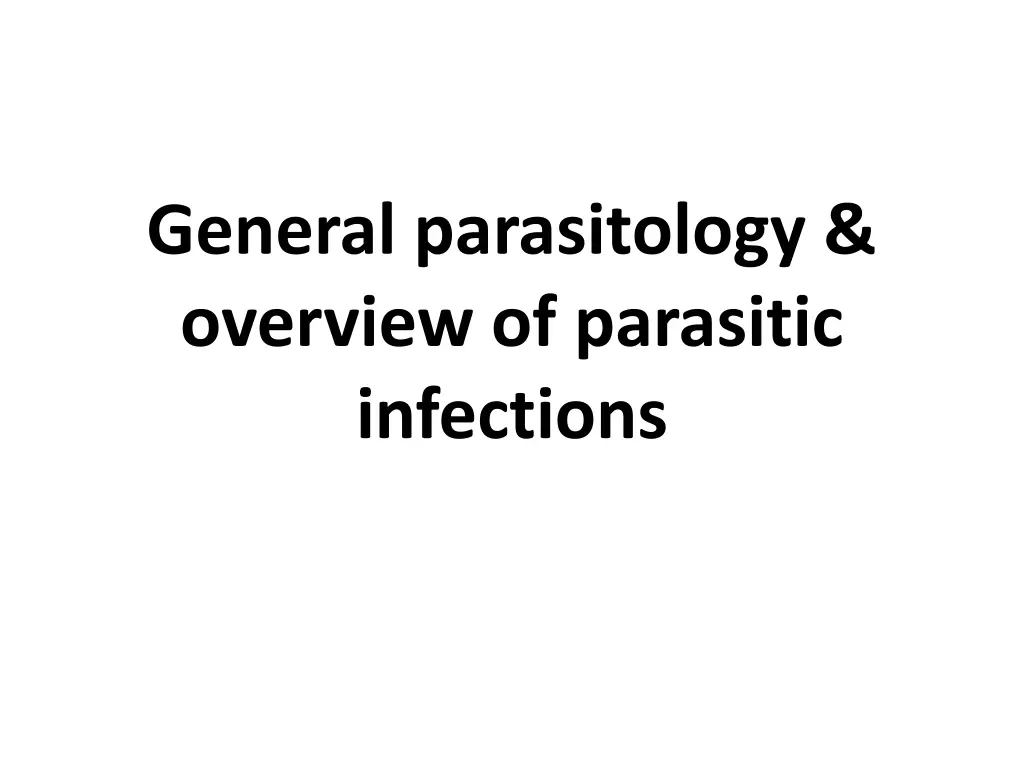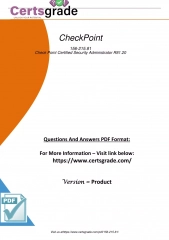
Parasitology and Overview of Parasitic Infections
Explore the classification, life cycles, laboratory diagnosis, and treatment of parasitic infections including protozoan and helminth infections. Discover the medically important parasites that can impact human health.
Download Presentation

Please find below an Image/Link to download the presentation.
The content on the website is provided AS IS for your information and personal use only. It may not be sold, licensed, or shared on other websites without obtaining consent from the author. If you encounter any issues during the download, it is possible that the publisher has removed the file from their server.
You are allowed to download the files provided on this website for personal or commercial use, subject to the condition that they are used lawfully. All files are the property of their respective owners.
The content on the website is provided AS IS for your information and personal use only. It may not be sold, licensed, or shared on other websites without obtaining consent from the author.
E N D
Presentation Transcript
General parasitology & overview of parasitic infections
Learning objectives Classify parasitic infections Discuss life cycle of parasites Describe laboratory diagnosis & treatment of parasitic infections
Parasite lives in or upon another organism (host) Derives nutrients directly from it, w/o giving any benefit to host Ectoparasites: Inhabit surface of body of host w/o penetrating into tissues; infestation (eg. fleas /ticks) Vectors transmitting pathogenic microbes Endoparasites: Live within body of host; infection (eg. Leishmania)
I. Protozoan infections Unicellular, possess cellular organelles & metabolic pathways similar to eukaryotes Only few are considered as human pathogens
Medically important protozoans Amoeba Entamoeba histolytica Free-living amoebae: Naegleria, Acanthamoeba, Balamuthia Flagellates Intestinal Flagellate: Giardia Genital Flagellate: Trichomonas Hemoflagellates: Leishmania & Trypanosoma Apicomplexa Malaria parasites & Babesia Opportunistic coccidian parasites: Toxoplasma, Cryptosporidium, Cyclospora, Cystoisospora, Sarcocystis Miscellaneous Protozoa: Balantidium coli, Blastocystis, Microsporidia
II. Helminths Elongated flat/ round worm- like parasites measuring few mm to meters Eukaryotic multicellular & bilaterally symmetrical Two phyla; 1. Platyhelminths (flat worms)- cestodes (tapeworms) & trematodes (flukes) 2. Nemathelminths- intestinal & tissues nematodes Three morphological forms: adult, larvae, eggs
Medically important helminths Cestodes Diphyllobothrium, Taenia, Echinococcus, Hymenolepis Trematodes or Flukes Schistosoma, Fasciola, Clonorchis, Opisthorchis, Fasciolopsis, Paragonimus Intestinal Nematodes Trichuris, Enterobius, Hookworm, Strongyloides, Ascaris Somatic Nematodes Filarial nematodes, Dracunculus, Trichinella
Differences between cestodes, trematodes, nematodes Properties Cestodes Trematodes Nematodes Shape Tape-like, segmented Leaf-like, unsegmented Elongated, cylindrical, unsegmented Head end Suckers present, some have attached hooklets Suckers present. No hooklets Nosucker,nohoo klets.Some have well developed buccal capsule Alimentary canal Absent Present but incomplete Complete from mouth to anus Body cavity Absent Absent Present Monoecious (except schistosomes) Sexes Monoecious Diecious
Classification of helminths based on habitat Cestodes Intestinal cestodes Trematodes Blood flukes Nematodes Intestinal nematodes Diphyllobothrium Taenia solium, T. saginata Hymenolepis nana Dipylidium caninum Schistosoma haematobium S. mansoni S. japonicum Trichuris trichiura Enterobius vermicularis Necator/ Ancylostoma Ascaris lumbricoides Strongyloides Hepatic flukes Fasciola hepatica Clonorchis sinensis Opisthorchis
Cestodes Trematodes Nematodes Somatic/tissue cestodes Intestinal flukes Filarial nematodes Wuchereria bancrofti Brugia malayi Loa loa Onchocerca Mansonella sp. Trichinella Dracunculus Fasciolopsis buski Taenia solium T. multiceps Echinococcus Lung flukes Paragonimus westermani
Life cycle of parasites Life cycle of parasites Depends up on 3 factors: host, mode of transmission & infective form Host: Organism harboring the parasite Definitive host: parasite undergoes sexual cycle Intermediate host: parasite undergoes asexual cycle 1. Direct/simple life cycle-parasite requires only one host to complete its development 2. Indirect/complex life cycle-parasite requires two/ three hosts (one definitive host, another one/ two intermediate hosts) to complete its development
Infective form: Morphological form of parasite which is transmitted to man Autoinfection: Few intestinal parasites may infect the same person by contaminated hand (external autoinfection) or by reverse peristalsis (internal autoinfection) Eg. Cryptosporidium parvum, Taenia solium, Enterobius vermicularis, Strongyloides stercoralis &Hymenolepis nana
Protozoa Host Mode of transmission Infective form Definitive Intermediate Entamoeba & Giardia Man - Ingestion Cyst (quadrinucle ated) Trichomonas vaginalis Man - Sexual Trophozoites Leishmania species Man Sandfly Vector-borne Promastigote s Trypanosoma cruzi Man Reduviid bugs Vector-borne Trypomastig otes Trypanosoma brucei Man Tsetse fly Vector-borne Trypomastig otes Plasmodium spp Anopheles Man Vector-borne Sporozoites
Mode of transmission Protozoa Host Infective form Definitiv e Cat Interm ediate - Toxoplasma gondii Ingestion, blood transfusion, vertical Tissue cysts, oocysts, tachyzoites Cryptosporid ium Ingestion, autoinfection Oocysts (sporulated) Man - Cyclospora, Cystoisospor a Oocysts (sporulated) Man Sandfly Ingestion
Cestodes Host Mode of transmission Infective form Defini tive Intermediate Taenia solium (intestinal taeniasis) Man Pig Ingestion Cysticercus larvae Taenia solium (cysticercosis) Man Man Ingestion, auto- infection Embryonated eggs Taenia saginata Man Cattle Ingestion Cysticercus larvae Echinococcus granulosus Dog Man Ingestion Embryonated eggs Hymenolepis nana Man - Ingestion, auto- infection Embryonated eggs Diphyllobothrium latum Man 1st- Cyclops, 2nd- Fish Ingestion Plerocercoid larvae
Trematodes Host Mode of transmission Infective form Defini tive Man Intermediate Schistosoma species Snail Skin penetration Cercaria larvae Fasciola hepatica 1st- Snail 2nd- Aquatic plants Man Ingestion Metacercaria larvae Fasciolopsis buski Paragonimus Man 1st- Snail, Ingestion Metacercari a larvae spp. 2nd- Crab 1st- Snail, 2nd Clonorchis spp., Man Ingestion Metacercari Opisthorchis spp. - Fish a larvae
Intestinal nematodes Host Mode of transmission Infective form Defini tive Intermedi ate Ascaris, Trichuris Enterobius spp. Man - Ingestion Embryonated eggs Man - Ingestion, autoinfection Skin penetration Skin penetration, autoinfection Embryonated eggs Hookworm Man - L3 filariform larvae L3 filariform larvae Man - Strongyloides stercoralis
Somatic nematodes Mode of transmission Infective form Host Definitive Intermedia te Mosquito and flies Man Vector- borne L3 Filariform larvae Filarial worms Dracunculus medinensis Man Cyclops Ingestion L3 larvae Trichinella spiralis Man /Pig - Ingestion L1 larvae
Laboratory diagnosis of parasitic diseases
Stool specimens collected in wide-mouthed, clean, leak-proof, screw capped containers, should be handled carefully Specimens other than stool: -Perianal swabs (cellophane tape or NIH swab) -Duodenal contents Timing: Collected before starting anti-parasitic drugs Frequency: At least 3 stool specimens collected on alternate days (within 10 days)
When to examine: - Liquid stool specimens: examined within 30 min - Semisolid stools: within 1hr - Formed stools: up to 24 hrs after collection For monitoring response to therapy: Repeat stool examination 3- 4 wks after therapy for intestinal protozoan infection & 5- 6 wks for Taenia infection If delay in transport: - Fecal specimens should be kept at RT - Preservatives (eg. 10% formalin) used to maintain morphology of parasitic cysts & eggs
Macroscopic examination - Mucoid bloody stool: acute amoebic dysentery - Color: Dark red stool- upper GIT bleed, bright red stool bleeding from lower GIT - Frothy pale offensive stool (containing fat); giardiasis Microscopic examination - Includes direct wet mount examination - Permanent staining methods
Direct Wet Mount (Saline and Iodine Mount) Drops of saline & Lugol s iodine are placed on left & right halves of the slide Small amount of feces is mixed to form a uniform smooth suspension Cover slip placed & examined under 10X for detection of helminths eggs & larvae; followed by 40X for protozoan cysts & trophozoites
Saline mount: trophozoites, cysts of protozoa, eggs & larvae of helminths Advantages - Motility of trophozoites & larvae - Bile staining property can be appreciated (appear golden brown) & non-bile stained eggs appear colorless
Iodine mount Advantages: Nuclear details of protozoan cysts, helminthic eggs/ larvae are better visualized Disadvantages: -Iodine kills parasites -Bile staining property cannot be appreciated
Permanent Stained Smear Required for accurate detection of protozoan cysts, trophozoites by staining their internal structures Commonly used methods are: Iron-hematoxylin stain Trichrome stain Modified acid-fast stain- useful for coccidian parasites
Concentration techniques - Direct examination may not detect parasites if yield is low - Useful in epidemiological analysis & for assessing t/t response Sedimentation techniques Floatation techniques Zinc sulphate flotation concentration technique Sheather s sugar flotation technique
Morphological forms of parasites seen in stool specimens Morphological form Parasites Trophozoite & cyst Entamoeba histolytica, Giardia lamblia Adult worm Ascaris lumbricoides, Enterobius vermicularis Taenia species, Diphyllobothrium latum Adult worm segments Egg Diphyllobothrium latum, Taenia species, Hymenolepis nana, Schistosoma species, Fasciola hepatica, Fasciolopsis buski , Ascaris lumbricoides, Hookworm, Enterobius vermicularis, Trichuris trichiura Larva Strongyloides stercoralis
Examination of blood Various methods of examination of blood are: Direct wet mount examination Examination of blood smears (thin smear, thick smear) Quantitative buffy coat (QBC) Concentration of blood
Microscopic examination of various specimens Specimen Peripheral blood smear Morphological form Ring form, schizont gametocyte Parasite Plasmodium spp. Amastigote Trypomastigote Leishmania spp. Trypanosoma spp Microfilaria Filarial nematodes Bone marrow, liver, lymph node, splenic aspirate Tachyzoite Toxoplasma gondii Leishmania donovani Amastigote Entamoeba histolytica Liver aspirate Trophozoite
Specimen Morphological form Parasite Lymph node aspirate Trypomastigote Trypanosoma spp. Lymph node biopsy Adult worm Wuchereria bancrofti, Brugia malayi Naegleria fowleri Acanthamoeba CSF Trophozoite Trypomastigote Trypanosoma spp. Urine Trophozoite Trichomonas vaginalis Microfilaria Wuchereria bancrofti Egg Schistosoma haematobium
Specimen Morphological form Adult worm Egg Larva (migrating) Parasite Sputum Paragonimus spp. Paragonimus spp. Ascaris Strongyloides Hookworm Trophozoite Entamoeba histolytica Duodenal aspirate Trophozoite Giardia lamblia Larva Strongyloides stercoralis Corneal scrapings Trophozoite Acanthamoeba spp.
Morphological form Specimen Parasite Skin Amastigote Leishmania spp. Microfilaria Onchocerca volvulus Larva in skin ulcer fluid Dracunculus medinensis Muscle tissue Encysted larva Trichinella spiralis Cysticercus cellulosae Egg Taenia solium Perianal area Enterobius
Immunodiagnostic Methods - Detection of parasite specific Ab - Circulating parasitic Ag in serum Useful when: Parasites are detected only during early stages of disease Parasites occur in very small numbers Parasites reside in internal organs & morphological identification is not possible When other techniques like culture are time consuming
Antibody detection tests Ab are detected in from serum or CSF (neurocysticercosis) or pleural fluid (paragonimiasis) ELISA in amoebic liver abscess Visceral leishmaniasis- immunochromatographic test (ICT) Toxoplasmosis: Sabin-Feldman dye test, detection of specific IgM or IgA or IgG antibodies by ELISA Cysticercosis: ELISA, Western blot Hydatid disease: ELISA Lymphatic filariasis: Flow-through assay
Antigen detection tests Amoebiasis: ELISA in blood/ stool Triage parasite panel: ICT detects 3 Ag in stool (Giardia, E. histolytica, Cryptosporidium) Malaria: ICT Histidine rich protein-2 (Pf. HRP 2)- P. falciparum specific Parasite lactate dehydrogenase (pLDH) & aldolase Lymphatic filariasis: ELISA & ICT
Molecular methods PCR, real time PCR LAMP assay BioFire FilmArray: automated multiplex nested PCR. The gastrointestinal panel can simultaneously detect 22 enteric pathogens, including 4 parasites (E. histolytica, G. lamblia, Cryptosporidium, Cyclospora)
Other tests Culture techniques Imaging techniques Intra-dermal skin tests Xenodiagnostic technique Animal inoculation methods
Anti-parasitic agents Parasite Anti-parasitic agents Entamoeba histolytica Metronidazole, tinidazole Diloxanide furoate Giardia species Metronidazole, tinidazole Trichomonas Metronidazole, tinidazole Trypanosoma cruzi Benznidazole, nifurtimox Trypanosoma brucei Pentamidine, suramin Leishmania donovani Amphotericin B, Antimonials Paromomycin, Miltefosine Plasmodium species Chloroquine, Quinine, Artemisinin derivative Primaquine, Mefloquine, Sulfadoxine-pyrimethamine Lumefantrine
Protozoa Anti-parasitic agents Cryptosporidium Nitazoxanide Cyclospora Cotrimoxazole Cystoisospora Cotrimoxazole Toxoplasma Cotrimoxazole, spiramycin Microsporidia Albendazole Balantidium coli Tetracycline Praziquantel, Niclosamide, Albendazole Cestodes Praziquantel, Triclabendazole for Fasciola hepatica Trematodes Intestinal nematodes Mebendazole, albendazole, Pyrantel pamoate Ivermectin (for Strongyloides) Diethylcarbamazine (DEC) Albendazole, Ivermectin Filarial nematodes

